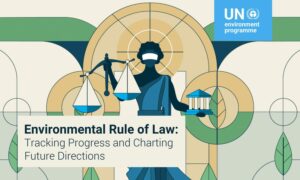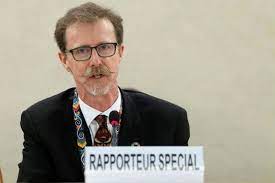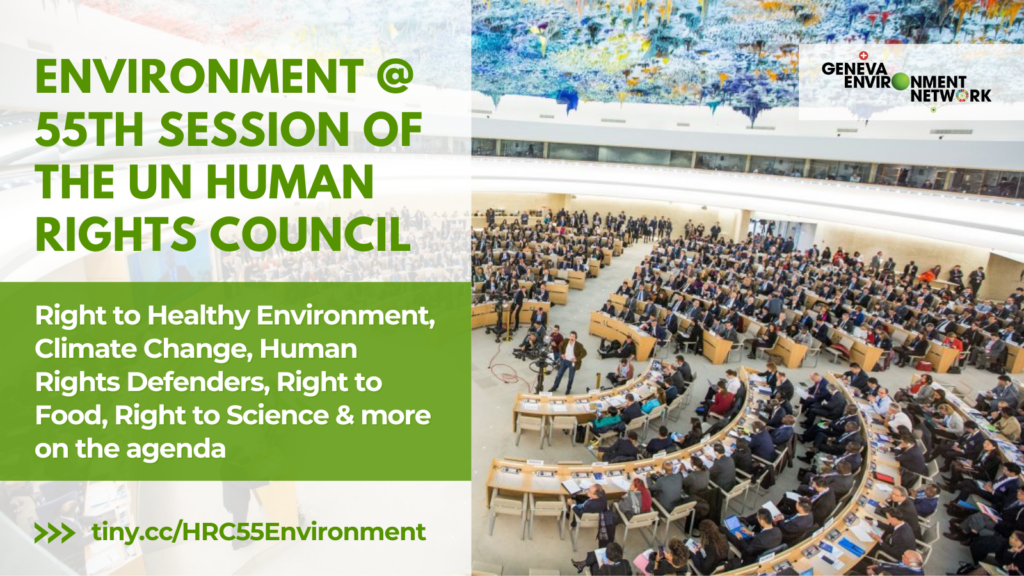Event Conference
Environmental Rule of Law: Tracking Progress and Charting Future Directions | Global Report Launch

12 Mar 2024
10:00–11:30
Venue: International Environment House I | Room 2 & Online | Webex
Organization: United Nations Environment Programme, Geneva Environment Network
The global launch of the report "Environmental Rule of Law: Tracking Progress and Charting Future Directions", organized by the UN Environment Programme and the Geneva Environment Network,l introduced its findings and recommendations and facilitate discussions aimed at promoting and strengthening environmental rule of law.

About this Session
The world is facing the triple existential threats of climate change, catastrophic loss of biodiversity, and growing chemical contamination. In the face of this triple planetary crisis, environmental rule of law has never been more important or relevant. Environmental rule of law provides an essential toolbox of approaches for strengthening the implementation and enforcement of, and compliance with, environmental law. It empowers us to fortify the application, strengthen enforcement, and ensure better environmental actions for the planet for both present and future generations.
With an aim to support the promotion and strengthening of environmental rule of law, the UN Environment Programme (UNEP) published the second environmental rule of law report, Environmental Rule of Law: Tracking Progress and Charting Future Directions in November 2023. Building on the first Global Report, this Report expands the initial findings to provide a comprehensive data-informed assessment of global trends, gaps and opportunities related to environmental rule of law. The Report also provides a range of good practices. By presenting good practices, UNEP aims to deepen understanding of environmental rule of law through case studies and inspire states and other stakeholders to replicate good practices whenever possible.
In addition, UNEP, in collaboration with its partners, developed and collected data on a series of questions related to each of the key components of environmental rule of law: laws, institutions, civic engagement, rights and justice. By analysing data on these indicators, UNEP has created a global snapshot of environmental rule of law to identify which aspects of environmental rule of law are most prevalent across countries, and to track progress over time.
This global launch of the Report introduced its findings and recommendations and facilitated discussions aimed at promoting and strengthening environmental rule of law. This event is the first of a series of regional and thematic seminars organized by UNEP that will convene leading experts on environmental rule of law, including contributors to the Report, to encourage information sharing and in-depth discussions.
Speakers
By order of intervention.

Arnold KREILHUBER
Director, Europe Office, UN Environment Programme

Lydia SLOBODIAN
Director, Environmental Law and Policy Program, Georgetown University

Ana Maria SUAREZ FRANCO
Accountability Coordinator & Representative in Geneva, FIAN International

David BOYD
UN Special Rapporteur on human rights and the environment

Nambitha DAMBUZA
Judge, Supreme Court of Appeal, South Africa

H.E. Amb. Toleafoa Nella TAVITA-LEVY
Permanent Representative of Samoa to the UN and other international organizations in Geneva

H.E. Amb. Carlos SORRETA
Permanent Representative of the Philippines to the UN and other international organizations in Geneva

Yves LADOR
Representative of Earthjustice to the United Nations in Geneva | Moderator
Highlights
Video
Live from the International Environment House 1
Live on Facebook
Summary
To be continued.
Opening
Arnold KREILHUBER | Director, Europe Office, UN Environment Programme
- This event is intended to incentivize information sharing and in-depth discussions on environmental rule of law with some of the world’s leading experts on the topic to delve a little bit deeper into the findings of the second report and what they mean for environmental law and the Global Environmental challenges the world faces.
- Environmental rule of law is generally understood as applying the principles of the rule of law in an environmental context. I always underline that when this definition is made, there are perhaps two distinct aspects of environmental rule of law as compared to the general rule of law. Number one is what may be described as the precautionary approach, this element of scientific uncertainty and the second aspect would be the intergenerational aspect, the rights of future generations.
- Why environmental rule of law is important may seem obvious but environmental rule of law has helped to shine a light on the importance of strong environmental laws and institutions. These are essential to achieving environmental goals and developing effective responses to pressing environmental crisis.
- Laws provide the requirements, the standards, the procedures, and the rights necessary to achieve environmental objectives. Strong institutions are necessary to give force to those environmental laws and these environmental rights and this is even more important now that we have the universal recognition of the right to a clean, healthy, and sustainable environment.
- In addition to environmental benefits, environmental rule of law provides economic and social benefits by providing the protection of the natural environment. Environmental rule of law protects public health, and economically valuable natural resources.
- By increasing transparency and reducing corruption, environmental rule of law can attract investment support, sustainable economic growth, and ensure that resulting benefits to nature are shared.
- Environmental rule of law not only operates in a vacuum, but it is really a crosscutting objective that needs many more stakeholders than just those that have been traditionally involved in environmental law, it needs to really bring together many other actors, a whole-of-society approach to really deliver the benefits that are intended through all the laws and multilateral environmental agreements that have been adopted up until now.
- If there is an absence of environmental rule of law, it would undermine good governance and that again beyond the environmental sector. A consistent, fair, and effective implementation of environmental law strengthens the perceived legitimacy of government action and builds public confidence in institutions.
- Despite the global proliferation of national laws and institutions over the past 50 years, the implementation and enforcement have lagged behind other sectors resulting in a crisis of pollution, biodiversity loss and climate change. We need to increase efforts to close this implementation gap with extreme urgency to avoid dire consequences of environmental problems.
- The second report underlines that effective legal frameworks and capable institutions are the foundation of environmental rule of law especially when they are unambiguous informed by reliable data fair and gender and culture sensitive considerations. The report also shows that technology can revolutionize environmental policy making and enforcement however questions of transparency, bias, and privacy might undermine its effectiveness and jeopardize people’s rights therefore highlighting the need for broad public participation in its implementation.
- Civic engagement is another critical aspect of environmental rule of law, and it is very pleasing to see that a growing number of countries have enacted legislation on access to information, rights of public participation, and access to justice. Despite this progress there is still a need for stronger laws and policies to protect especially environmental defenders against arbitrary arrests, violence, and death.
- During and before COVID-19, racial and social justice movements and protests around the world have also driven the engagement on environmental justice issues across the world. At the same time environmental groups have increasingly incorporated racial and social justice issues into their agenda.
- Because the implementation of these environmental rights is still uneven, many countries continue to struggle with the inequitable access to both natural resources and justice. The report clearly shows that the international community needs to make increased efforts to equip countries and stakeholders with the required tools to improve justice.
- Due to the transboundary nature of many environmental issues, justices and judges are becoming also more open to granting remedies to plaintiffs who have suffered environmental damage caused by foreign entities domiciled within their jurisdiction.
- UNEP will continue to provide support to governments, to institutions, to civil society, to the legal community and other key actors in the pursuit of our common objective to improve environmental rule of law and really make sure that environmental law delivers for people in the planet as we address the global environmental challenges.
Panel Discussion | Cross-cutting Issues
Lydia SLOBODIAN | Director, Environmental Law and Policy Program, Georgetown University
We identified four cross-cutting themes.
COVID-19 Pandemic | The first one is the pandemic because we drafted the report while we were living through the pandemic. It was a daily factor in our lives, but it also really showed the impact on environmental rule of law.
- Covid-19 had an unprecedented social, economic, and health impact, that had a direct impact on the environment. The decrease in economic activity has led to a global decrease in emissions of greenhouse gases as well as a decrease in ocean noise. It has also led to an increase in plastic pollution such as single use medical supplies and led to an economic downturn creating pressures on natural resources and disproportionate impacts on most vulnerable communities through cumulative impacts. The environmental and health effects increased mortality rates.
- Countries responded in different ways. In some cases, countries adopted new laws that were intended to strengthen environmental rule of law in the face of the pandemic while others relaxed regulations and enforcement, for example social distancing rules may have made it harder or impractical for companies to meet some of their environmental reporting obligations or for inspectors to reach firms to evaluate their environmental performance.
- Covid also affected civic engagement. It limited opportunities for in-person attendance at public hearings, in person judicial adjudications. However, it also may have led to innovation in virtual engagement and judicial proceedings that in some ways can increase access to justice and increase civic engagement.
- Despite the impacts on human lives, we must see opportunities coming out of this global catastrophe. One big lesson is that an investment in environmental rule of law is an investment in health. Whether or not this pandemic was caused by something related to illegal wildlife trade, it is certain that there is a link between environmental degradation and human health. We know that environmental degradation can increase incidence of zoonotic disease and that environmental degradation can create these cumulative factors that make a pandemic more serious. We have a chance to consider these and build more inclusive and accessible systems and processes using the innovative ideas we had to create to survive the Covid pandemic and take them forward as new best practices.
Technology | The second one is technology, the role of emerging technology in implementing environmental rule of law in realizing environmental rule of law even in developing laws.
- There is a huge surge in technology, not just the technology that is available but also the ways we use this technology in environmental monitoring and enforcement. Earth observation and satellite imagery has been used to detect illegal activity from deforestation to illegal mining, machine learning and AI that provide opportunities to process this monitoring and enforcement data. AI mechanisms allow much more precise and, in some cases, quasi real-time enforcement data.
- We are seeing a use of technology in citizen engagement through for example citizen science or using social media in organizing civic engagement.
- This creates virtual opportunities to access justice and to participate in rule making processes. There is also more reliance on reporting of citizens such as identifying rules, violations, like idling in the city or littering or pollution. We are seeing the use of technology in drafting and interpreting law, and we mostly drafted this report prior to the explosion of AI tools like chat GPT, that are being used by lawyers and lawmakers to conduct legal research to develop legal documents.
- The dangers of overreliance on technology are this idea of garbage in, garbage out. This is the idea that what you put into your computing systems can also have human biases. Hence, there is a danger of getting a biased system if you are putting in incorrect or misleading information.
- A second danger is the growing digital divide. Even if there are civic engagement processes and justice processes online, those can increase access but only for those who have a strong internet connection, which is not everyone in the world.
- Life privacy and digital security are also rights concerns because exposed to malicious use of the internet platforms.
Connection Between Movements | The third one is this connection between movements for racial and social justice and environmental justice.
- The racial and social justice issues became so salient that they were impossible to ignore even in a global health crisis.
- The disproportionate environmental impacts on racial minorities and disadvantaged social groups were already a theme in social justice movements. This includes cumulative impacts or what have been called sacrifice zones.
- We saw both the environmental community taking recognition of the social justice and racial justice impacts of environmental decision-making and social justice groups including Black Lives Matter recognizing the importance of environmental factors and environmental justice.
- Similarly, we saw growing global recognition of connection between environmental rights and human rights and this manifests as the recognition of the importance to defend the defenders, to protect their rights and make connections between race and environmental enforcement.
- Social justice groups and environmental justice groups are at the forefront of civic engagement and lawmaking to recognize vulnerable communities and racial and social minorities as victims and for the recognition of the importance of diversity and inclusion in environmental institutions based on the idea that more diverse groups, more diverse perspectives will make better decisions because will bring in different views and different ways of thinking about problems. For example, women, indigenous peoples, racial minorities, and youth can really take the lead as environmental champions.
Climate Change | The final one was climate change, and we went back and forth on including that as a cross-cutting theme linked to the triple crisis. There are a lot of movements on environmental law around climate change from the laws and institutions to civic engagement, to rights, to justice.
- There has been an explosion in awareness of the climate problem including public awareness and awareness among policy makers.
- At least 34 countries have declared climate emergencies at the time the report was written and over 2,300 climate change cases filed in 55 countries.
- These cases demonstrate a human rights approach to climate litigation and a connection to future generations and the current youth.
- Finally, the UN resolutions on climate change and human rights recognize the importance of this issue.
Ana María SUÁREZ FRANCO | Accountability Coordinator & Representative in Geneva, FIAN International
David BOYD | UN Special Rapporteur on human rights and the environment
Panel Discussion | Judiciary and Increase in Litigation
Open Discussion
Closing
Environment @ HRC55
The 55th regular session of the Human Rights Council (HRC55) is taking place in Geneva and online from 26 February to 5 April 2024. This regularly updated page highlights the environmental-related activities of this session.























